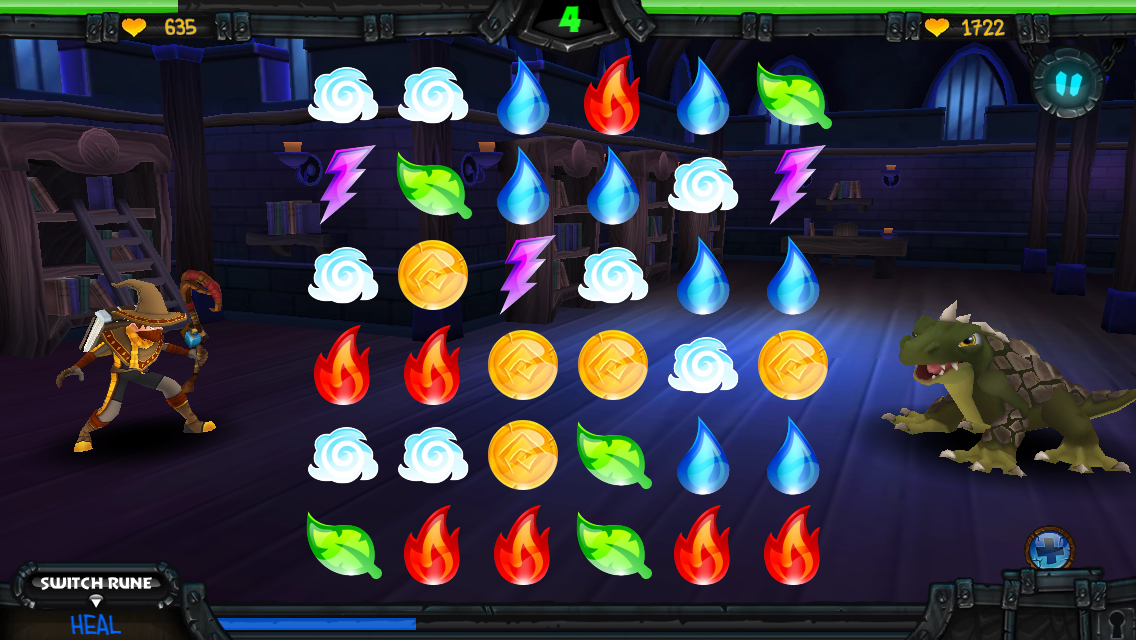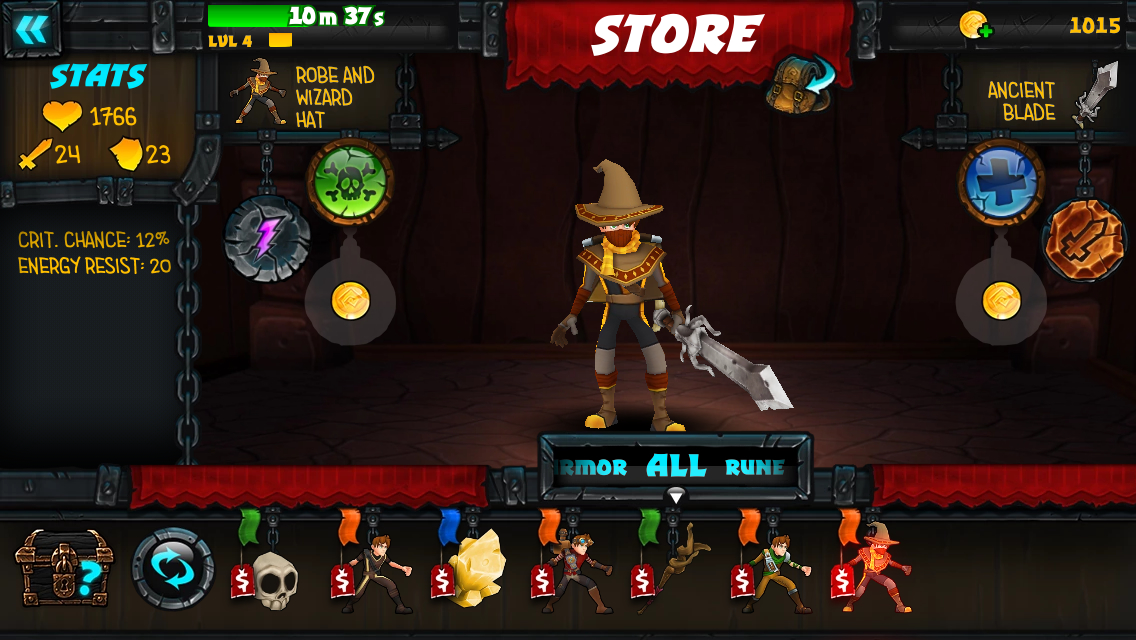 I’ve played a lot of free-to-play RPGs, and they all tend to have the same strengths and weaknesses. That’s probably due to most of them being inspired by the model used in the popular Puzzle & Dragons (Free), following its formula as closely as possible in hopes of achieving similar levels of success. Now, I like that game quite a bit, but even I’m getting a little tired of getting into a new game only to see the same old mechanics powering it. There must be other effective ways to monetize your puzzle RPG besides monster-collecting and stamina meters. Spellfall: Puzzle RPG (Free) takes a different approach, avoiding many typical elements such as multiple currencies, drawing random monsters, and nudging you to expand your inventory. Unfortunately, the game also has its own take on the stamina meter concept that seems on paper like it would be better, but in practice doesn’t quite work out.
I’ve played a lot of free-to-play RPGs, and they all tend to have the same strengths and weaknesses. That’s probably due to most of them being inspired by the model used in the popular Puzzle & Dragons (Free), following its formula as closely as possible in hopes of achieving similar levels of success. Now, I like that game quite a bit, but even I’m getting a little tired of getting into a new game only to see the same old mechanics powering it. There must be other effective ways to monetize your puzzle RPG besides monster-collecting and stamina meters. Spellfall: Puzzle RPG (Free) takes a different approach, avoiding many typical elements such as multiple currencies, drawing random monsters, and nudging you to expand your inventory. Unfortunately, the game also has its own take on the stamina meter concept that seems on paper like it would be better, but in practice doesn’t quite work out.
Spellfall is a stage-based match-3 puzzle game with RPG elements. In this particular variety, each stage has a set number and type of enemies that you can preview beforehand. On entering the stage, you get a set number of turns to make matches before the enemy retaliates. Pieces come in five differently-colored elements, along with some coin pieces. You can pick up any piece on the board and switch it with any other piece, with any match besides coins resulting in damage to the enemy. If you make matches of more than three pieces at one time, you’ll earn special blocks that allow you to perform direct magical attacks or clear entire rows or columns at once. Take the enemy’s HP down to zero, collect your experience and coins, and you can move on to the next stage.
That’s how it should work, anyway, but as this is a free-to-play game, there are certain catches, of course. The biggest one, and the one that ends up dragging the game down, is its variation on the popular stamina meter found in many free-to-play games. Usually, you have a meter that is depleted each time you play a stage, allowing you to play perhaps five or six games before it has to be recharged one way or another. Spellfall does not have a gauge like this. You can take on as many stages as you want. There’s just one little rub. Unless you happen to gain a level at the end of a stage, your HP are carried over as-is to the next stage. With the way it’s balanced, you won’t be far into the game before enemies start getting tough enough to leave you with less than half a life bar at the end of a fight. You might pull two fights out if you’re on top of healing or finish off the monsters quickly, but it’s very unlikely you’ll be in any shape for a third battle.
There are two ways to refill your life bar. You can pay some of your hard-earned coins to top off the bar, or you can simply wait in real time. Your HP restores fairly quickly, but the higher your level gets and the more HP you have, the longer that wait will be, or if you choose to pay in coins, the more it will cost you. It’s not that it feels unfair to me, all things considered, but whether or not it’s fair, the end result is still only being able to play one or two matches before you have to wait for the whole thing to fill up again. It’s too much waiting for too little play, and it only gets worse the longer you play.
There’s just one currency, coins, and while you can buy them with real money if you want to, you’ll also be earning them as you play. The game is actually reasonably generous in handing them out to you, and this is one aspect that gets better the more you play. After conquering a set of stages, you’re able to harvest gold from them every so often just by tapping them on the map. With prices being what they are, you’re still going to have to save up for a while to get the best gear, but I don’t think that’s necessarily a bad thing. Coins are used for just about everything in the game. Of course, you can buy new gear with them, but you can also top off your HP, buy one-use boosts before fights, and upgrade your equipment. The only thing you can’t use coins for are revivals and buying treasure boxes. Each individual revival requires you to purchase a $0.99 IAP, while the treasure boxes are available for a variety of prices. The game gives you a free box from the lowest tier every day, which is nice even if it usually ends up being something you’re likely to sell right away.
The catch with the gear shop is that while you might want to save up for a particular piece of equipment that appears, it’s pretty hard to do so. Every time you clear a battle, a new random piece of gear will appear in the shop, but the oldest piece currently available will be retired. The really cool items are priced so high that you’ve got little chance of getting together enough coins to get them if you don’t already have a bunch saved. The game certainly isn’t shy about letting you know a piece of gear is going away, trying to tempt you one more time to invest in some coins. It’s not that hard to just let things go, though, as generally speaking the equipment that appears in the shop only gets better the farther in you play. You will want to grab certain runes if they appear, but if you miss them, they’ll always come back sooner or later.
It’s pretty fun to collect new gear, since it changes the appearance of your character as well as his stats and abilities. Different weapons and armor have a certain number of maximum rune slots you can use coins to open up. You can slot the runes of your choice into them for various spells and effects. The spells can be charged up by making matches of the same element, while the other runes are generally passive and do things like boost your attack or add a leech effect to your strikes. Getting that visible change in addition to making your character a little stronger ensures that it’s always pretty satisfying to get something new.
Sooner or later, though, you hit the difficulty wall. Enemies start doing far more damage than you can stay on top of, and since losing means you have to wait twenty minutes or more for a recharge to make another honest attempt, it’s very frustrating to get cut down in a matter of seconds. At this point, all you can do is go back to earlier levels and slowly grind out some coins and experience to get stronger. At least against easier enemies, you can do several battles before you’re worn down enough to have to stop, but it’s not exactly fun to stomp enemies that pose little threat. The actual puzzle gameplay lacks the spice to carry the game through these grinding periods, so I expect most people are going to check out of the game as soon as they hit the first really nasty challenge spike.
If nothing else, it’s at least a pretty game, with good all-around production values. The UI is well-designed, the player character and enemies have a bunch of different animations for their attacks, the music is okay, and you even get to hear a Wilhelm scream now and then. It has Game Center support but only seems to use it so that you can poke at your friends to play. It’s also very interested in hooking up to your Facebook account for similar reasons. That’s great for people who are into that kind of thing, but it would be nice if there were some achievements to go with all of that if you’re going to use Game Center anyway.
In spite of all of my problems with the game, it’s still really fun while it’s rolling along. There’s nothing special going on with its gameplay, but its nice production values and enjoyable gear selection help compensate for its lack of imagination. I wouldn’t even mind the grinding half as much if I could do it against more challenging foes without having to wait between every couple of rounds. That misguided stamina substitute system sits at the root of most of Spellfall‘s problems, and it’s off-putting enough that I’d rather just go and play one of the many other match-3 RPGs available on iOS.


